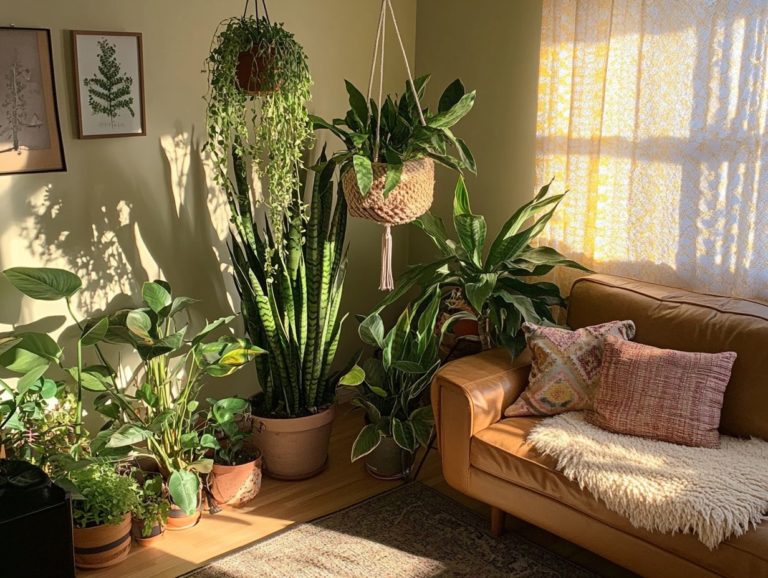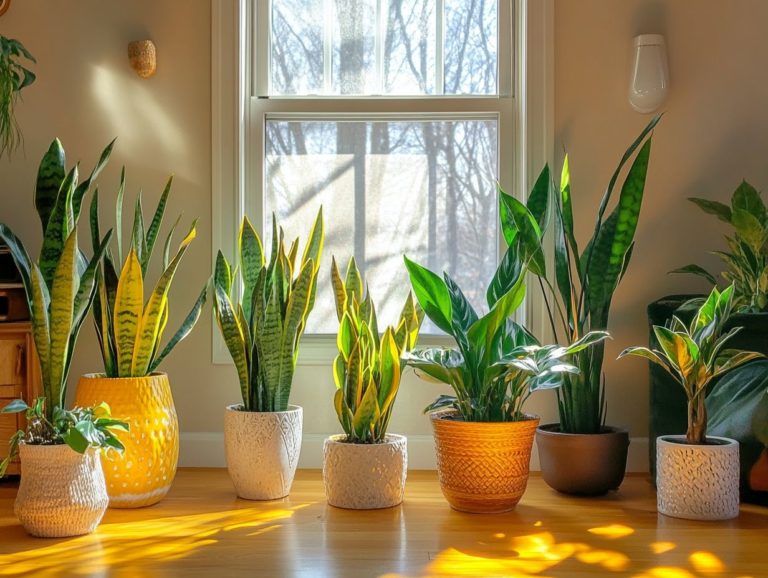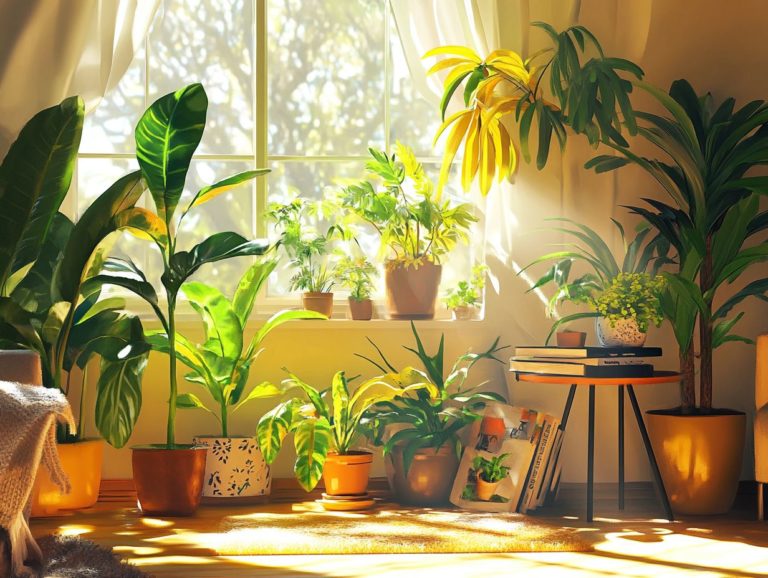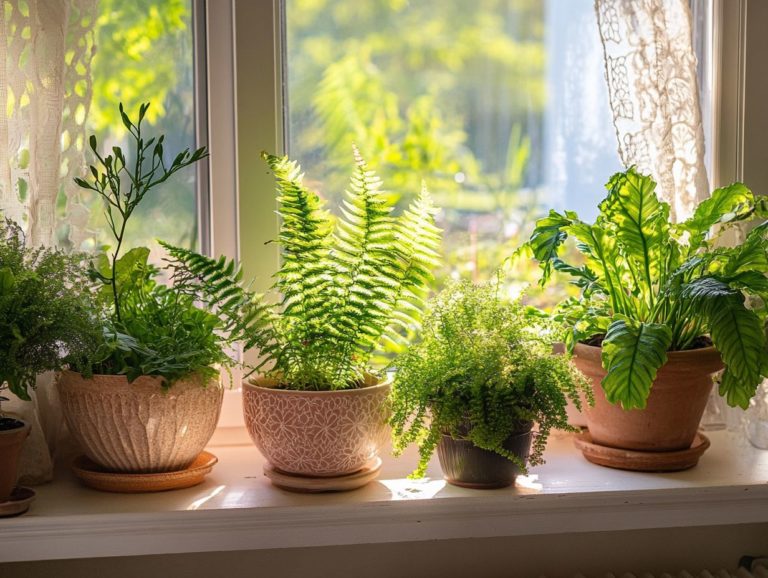Understanding the Spider Plant: Care Needs
Spider plants are cherished houseplants, celebrated for their vibrant green leaves and remarkable air-purifying abilities. With a range of popular varieties, these resilient plants integrate effortlessly into any home decor, enhancing your living space’s aesthetic.
Dive into essential care tips that will keep your spider plants thriving! You’ll find guidance on everything from light and temperature to watering needs, plus strategies for tackling common challenges like pests and yellowing leaves.
Explore effective propagation methods and discover innovative ways to incorporate spider plants into your environment. Embrace the beauty and numerous benefits these delightful plants can bring to your life!
Contents
Key Takeaways:
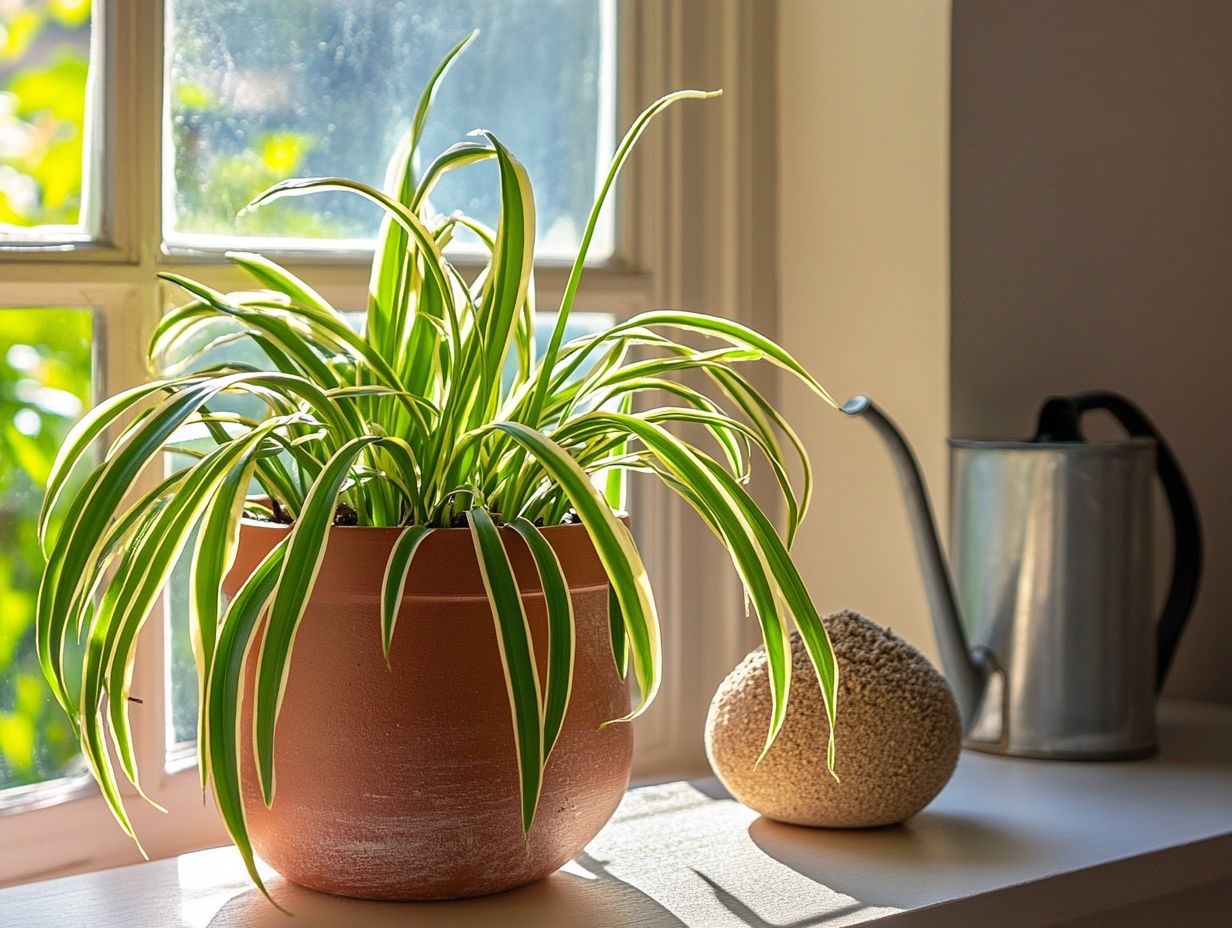
- Spider plants are popular houseplants known for their long, spindly leaves and easy care.
- Proper light, watering, and fertilizing are essential for maintaining a healthy spider plant.
- In addition to their decorative appeal, spider plants can also be propagated through various methods and used creatively in indoor and outdoor spaces.
What is a Spider Plant?
The spider plant, known scientifically as Chlorophytum comosum, is a standout choice for houseplants. It’s celebrated for its air-purifying abilities and its knack for thriving in various environments. Native to Africa, this resilient gem from the Asparagaceae family, known for its toughness, boasts long, arching leaves that add a vibrant touch to any indoor space.
Its easy-care nature makes the spider plant perfect for everyone, whether you’re a novice or a seasoned gardener looking to enhance your indoor plant collection.
With its charming green and white striped foliage growing in a delightful rosette pattern, it offers an eye-catching aesthetic. But it’s not just about looks; the spider plant diligently improves air quality by filtering out harmful toxins, making it a valuable addition for those who prioritize health and well-being.
This hardy plant loves bright, indirect light but can adapt to lower light too! It requires minimal watering just an occasional misting to keep its lush appearance intact.
When cared for properly, it flourishes and produces adorable offshoots, or pups, leading you to indoor gardening success while fostering a soothing atmosphere.
Popular Varieties
Spider plants come in several popular varieties, each bringing its own unique aesthetics and characteristics that align with your gardening preferences and styles. Among these, the ‘Variegatum’ stands out, showcasing striking white stripes that beautifully accentuate its lush green foliage. If you’re looking to add a touch of elegance to your indoor spaces, this variety is a top choice.
Conversely, the ‘Bonnie’ offers a playful twist with its charmingly curly leaves, infusing a sense of fun into any room. Both varieties thrive in bright, indirect light and prefer well-draining soil. A little occasional watering keeps them happy and hydrated.
Propagation is delightfully simple; just take the offsets and replant them for new growth. Interestingly, these plants can even surprise you with delicate floral blooms when conditions are just right, rewarding your nurturing efforts with a delightful display.
Basic Care for Spider Plants
To cultivate healthy, flourishing spider plants, you need to understand their fundamental care requirements. This includes mastering watering techniques, identifying the ideal lighting conditions, selecting the right soil type, and maintaining proper humidity levels.
Using plant food occasionally will enhance their growth, ensuring they thrive in your care.
Start your spider plant journey today, and enjoy the beauty and benefits these plants offer!
Light and Temperature Requirements
Spider plants thrive in bright, indirect sunlight. This makes them a perfect fit for various indoor environments. While they can handle lower lighting conditions, you ll want to give them just the right amount of light.
Prolonged exposure to direct sunlight can scorch their leaves and stunt their growth. Too much shade may lead to leggy, weak stems and reduced variegation.
The ideal temperature for these plants ranges from 65 to 75 degrees Fahrenheit. This range plays a crucial role in their overall vitality. A consistent environment free from drafts will enhance their health, allowing for lush foliage and a robust appearance.
By understanding the delicate balance of light and temperature, you can significantly boost your chances of successfully growing these beloved indoor plants.
Watering and Fertilizing
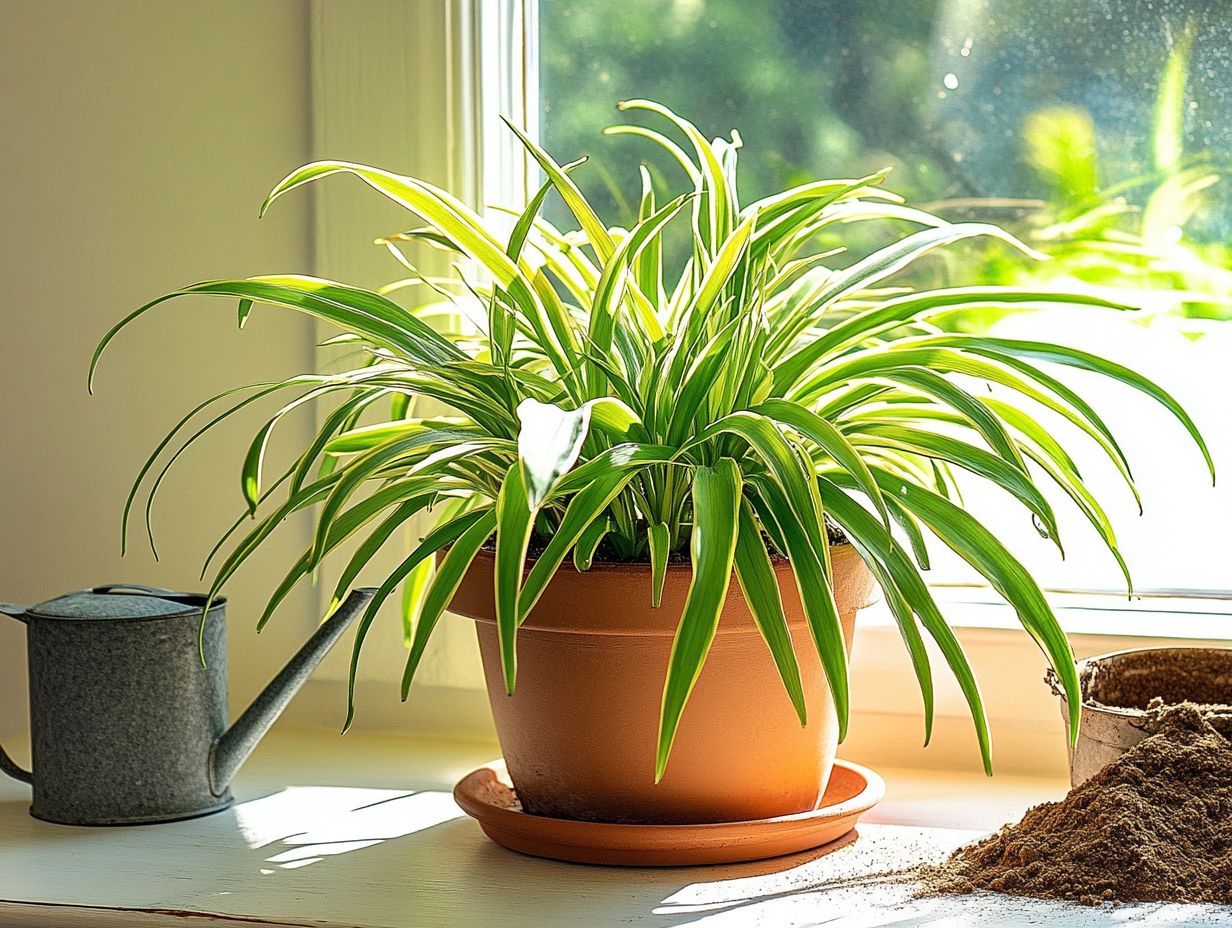
Proper watering and fertilizing are essential for keeping your spider plants healthy. Overwatering can lead to root rot, a condition that occurs when the roots sit in too much water and start to decay. Not enough water may result in unsightly browning leaves.
Finding the right amount of water is essential for lush, vibrant leaves. A good rule of thumb is to water your spider plants every 1-2 weeks, allowing the top inch of soil to dry out between waterings.
To check when it s time to water, simply stick your finger in the soil; if it feels dry, it s time to give your plant a drink. Use a well-draining potting mix to allow excess water to escape, minimizing the risk of rot.
Regarding nutrition, opt for a balanced, water-soluble fertilizer to support strong growth. Ideally, apply it every 4-6 weeks during the growing season.
By adhering to these guidelines, you can cultivate a thriving spider plant that brings beauty and life to your indoor space.
Common Issues and Solutions
Even the most resilient spider plants can face challenges like pests, diseases, and environmental stressors. These issues need your immediate attention! Symptoms may manifest as yellowing or brown leaves, which require prompt action to implement effective solutions.
Pest and Disease Management
Managing pests and diseases in your spider plants is crucial for their longevity and vitality. Common pests like spider mites and aphids can cause serious damage if you don t address them promptly.
Ignoring these issues can lead to stunted growth and unsightly foliage, or even the death of your beloved plant! Regular monitoring is essential to prevent such unfortunate outcomes.
Consider implementing natural remedies, such as neem oil or insecticidal soap, to effectively manage infestations. Maintaining optimal growing conditions adequate moisture, bright indirect light, and proper soil drainage can significantly reduce the risk of pests.
If things get really out of hand, chemical treatments can be used, but they should be approached with caution. By adopting a mix of these preventive strategies and treatments, you can create a healthy environment that supports the vibrant growth of your spider plants.
Yellowing and Browning Leaves
Yellowing and browning leaves are common issues that you might encounter with spider plants. These often signal problems related to watering, lighting, or nutrient deficiencies. When those vibrant green leaves begin to show signs of distress, it becomes essential to investigate the underlying causes.
Overwatering is a frequent culprit; excessive moisture can lead to root rot, impacting the plant’s vitality. Conversely, insufficient light may cause the leaves to lose their bright hue, making it crucial to ensure adequate indirect sunlight.
Nutrient deficiencies, particularly a lack of nitrogen or iron, can also manifest through discoloration. Timely fertilization becomes necessary to address these issues.
By closely observing these symptoms and adjusting your care routine, you can significantly enhance the resilience and beauty of your spider plants.
Propagation of Spider Plants
Propagation of spider plants is a truly rewarding endeavor! These delightful plants produce charming little plantlets that can be effortlessly rooted in either soil or water. This gives you the perfect opportunity to expand your indoor collection with ease.
Have you tried propagating your spider plants? Share your success stories!
Methods and Tips for Successful Propagation
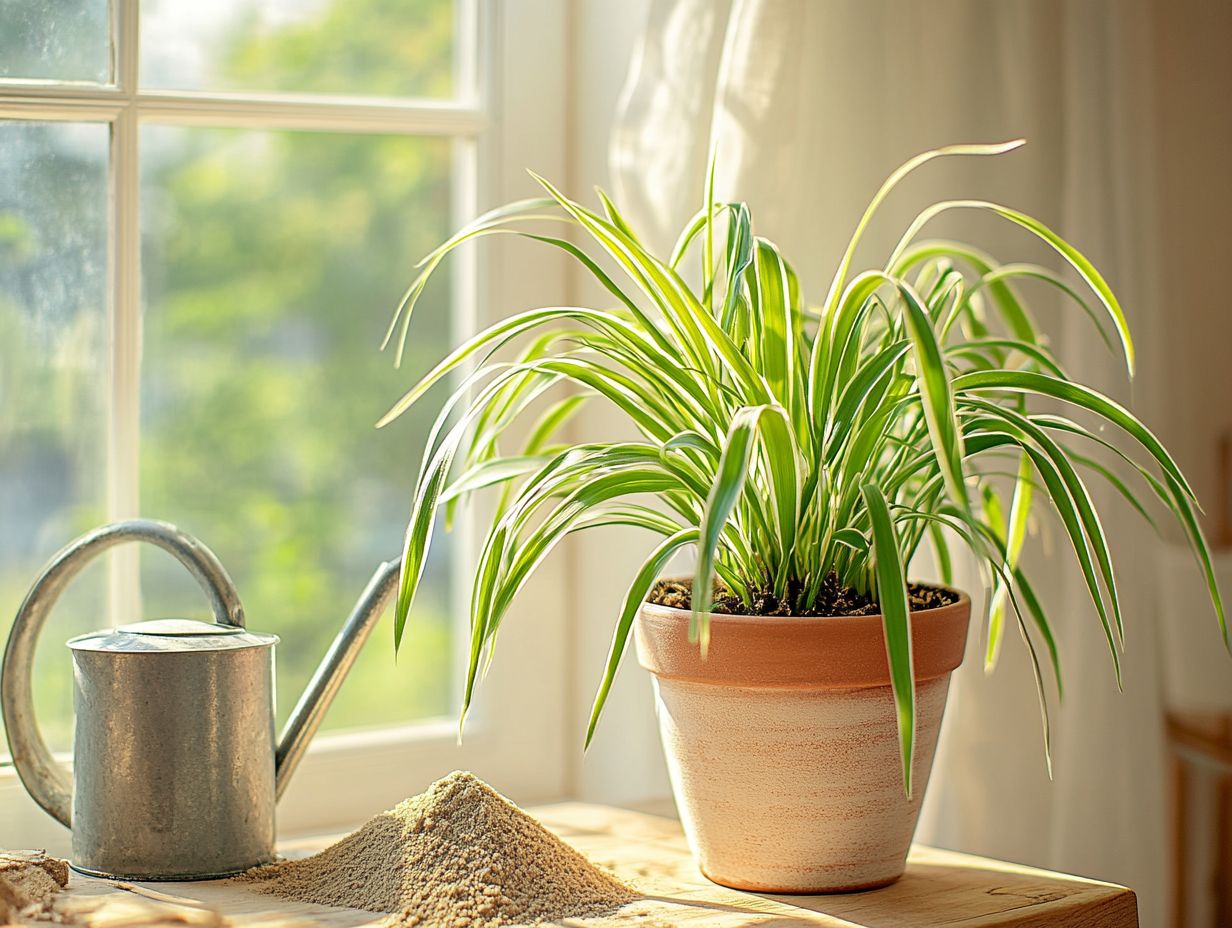
There are several effective methods for growing new spider plants, each with unique benefits and specific conditions for success.
One popular method is division, where you gently separate the plant’s baby plants, or spiderettes, and replant them. This method helps your new plants settle in faster and thrive!
Another engaging approach is water propagation, where you place cuttings in water until they develop roots. This gives you the exciting chance to watch the growth process firsthand.
Soil propagation is also a great option, as it provides immediate support and access to nutrients. To ensure your new plants develop healthily, use clean tools and soil that lets water through easily. Maintaining humidity and providing adequate light without direct sunlight will help your new spider plants truly flourish.
Creative Uses for Spider Plants
Spider plants are not just famous for their exceptional air-purifying qualities; they also offer amazing versatility for both indoor and outdoor decor. This makes them a beloved choice for gardeners and interior designers alike, bringing a touch of greenery to your spaces while enhancing your aesthetic.
Indoor and Outdoor Decor Ideas
When it comes to elevating your indoor and outdoor decor, spider plants offer countless creative options to enhance both beauty and environmental quality.
Their remarkable adaptability makes them an excellent choice for transforming any space. For instance, imagine a spider plant gracefully cascading from a chic hanging basket in your living room it’s an instant touch of greenery that cleverly conserves precious floor space. In your kitchen, think about using smaller pots to create an inviting herb station, as these plants thrive in bright light.
When arranged on shelves or nestled in attractive ceramic pots, they can become captivating centerpieces, showcasing that their appeal and versatility extend well beyond simple foliage.
Frequently Asked Questions
What are the care needs for a spider plant?
The main care needs for a spider plant include proper watering, adequate lighting, and occasional fertilization. Regularly trimming off brown or dying leaves is also essential to promote new growth.
How often should I water my spider plant?
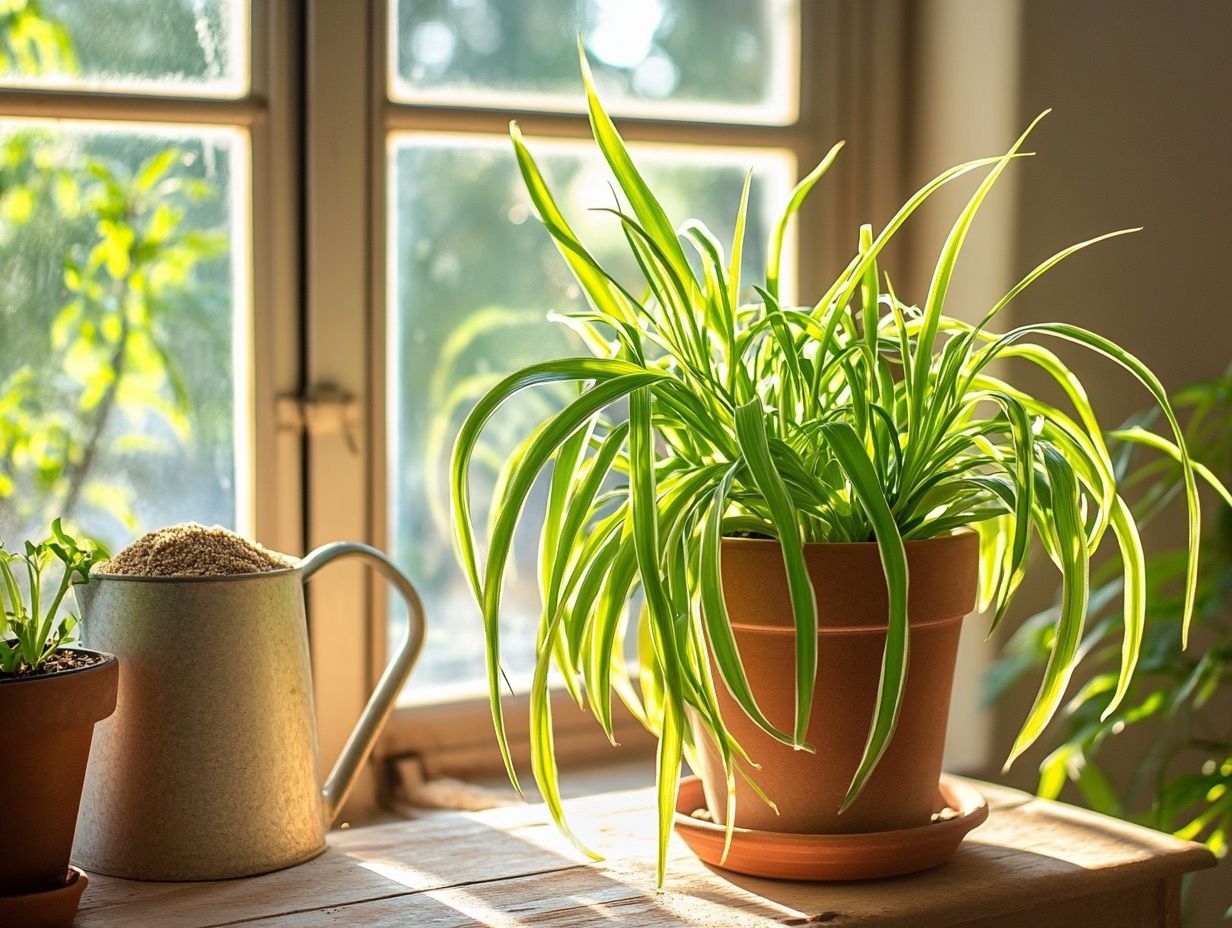
Spider plants should be watered once a week, allowing the soil to dry out slightly between waterings. Over-watering can lead to root rot, while under-watering can cause the leaves to turn brown and wilt.
Does a spider plant need direct sunlight?
No, a spider plant does not need direct sunlight. In fact, too much direct sunlight can scorch the leaves. A bright, indirect light source is best for a spider plant.
Can I use tap water to water my spider plant?
Yes, tap water is safe for spider plants. However, if your tap water is high in minerals, it may cause the tips of the leaves to turn brown. Using filtered or distilled water can be beneficial in this case.
Do spider plants need to be repotted?
Spider plants should be repotted every 1-2 years or when the roots start to outgrow their pot. Look for roots coming out of the drainage holes or circling around the base of the plant as signs that it’s time to repot.
How can I propagate my spider plant?
Spider plants are easily propagated by removing the small offshoots, or “spiderettes,” that grow from the main plant. These can be planted in their own pots with moist soil and will eventually grow into full-sized spider plants.
Get started with your own spider plants today and enjoy their beauty and benefits!

